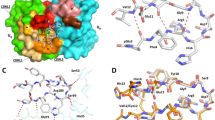Abstract
Neurotoxic beta-amyloid peptide plays an important role in the pathology of Alzheimer’s disease. In aggregated form it binds to several proteins on the surface of the brain cells leading to their death. p75 receptor involved in supporting of cell balance is one of the targets for toxic beta-amyloid. We proposed that induction of antibodies against potential binding sites of p75 with beta-amyloid can be a promising approach towards development of new anti-Alzheimer’s disease treatment. Four potentially immunoactive fragments of p75 were chosen and chemically synthesized. Investigation of immunoprotective effect of the peptide fragments carried out in mice with experimentally induced form of Alzheimer’s disease helped to reveal two fragments effectively preserving murine memory from impairment. Results obtained by ELISA biochemical analysis showed that only immunization with fragment p75 155–164 led to significant decrease in beta-amyloid level in the brain of the experimental mice. Thus, immunization with both fragments of p75 receptor pro-vides a new insight into anti-Alzheimer’s disease drug design.
Similar content being viewed by others
Abbreviations
- OBX:
-
olfactory bulbectomized
- DIEA:
-
N,N-diisopropylethylamine
- FCA:
-
Freund’s complete adjuvant
- FIA:
-
Freund’s incomplete adjuvant
- KLH:
-
keyhole limpet hemocyanin
- PBS:
-
buffer containing 137 mM NaCl, 2.7 mM KCl, 7.8 mM Na2HPO4, 1.5 mM KH2PO4, pH 7.4
- SO:
-
shamoperated
- TBTU:
-
2-(benzotriazole-1-yl)-1,1,3,3-tetramethyluronium tetrafluoroborate
References
Volosin, M., Song, W., Almeida, R.D., Kaplan, D.R., Hempstead, B.L., and Friedman, W.J., J. Neurosci., 2006, vol. 26, pp. 7756–7766.
Lee, R., Kermani, P., Teng, K.K., and Hempstead, B.L., Science, 2001, vol. 294, pp. 1945–1948.
Roux, P.P. and Barker, P.A., Prog. Neurobiol., 2002, vol. 67, pp. 203–233.
Schliebs, R. and Arendt, T., Behav. Brain Res., 2011, vol. 221, no. 2, pp. 555–563.
Coulson, E.J., May, L.M., Sykes, A.M., and Hamlin, A.S., J. Neurosci., 2009, vol. 15, no. 4, pp. 317–323.
Knowles, J.K., Rajadas, J., Nguyen, T.V., Yang, T., LeMieux, M.C., Vander, GriendL., Ishikawa, C., Massa, S.M., Wyss-Coray, T., and Longo, F.M., J. Neurosci., 2009, vol. 29, pp. 10627–10637.
Sotthibundhu, A., Sykes, A.M., Fox, B., Underwood, C.K., Thangnipon, W., and Coulson, E.J., J. Neurosci., 2008, vol. 28, pp. 3941–3946.
Knowles, J.K., Simmons, D.A., Nguyen, T.V., Vander, GriendL., Xie, Y., Zhang, H., Yang, T., Pollak, J., Chang, T., Arancio, O., Buckwalter, M.S., Wyss-Coray, T., Massa, S.M., and Longo, F.M., Neurobiol. Aging, 2013, vol. 34, no. 8, pp. 2052–2063.
Kamynina, A.V., Volpina, O.M., Medvinskaya, N.I., Aleksandrova, I.J., Volkova, T.D., Koroev, D.O., Samokhin, A.N., Nesterova, I.V., Shelukhina, I.V., Kryukova, E.V., Tsetlin, V.I., Ivanov, V.T., and Bobkova, N.V., J. Alzheimers Dis., 2010, vol. 21, no. 1, pp. 249–261.
Kamynina, A.V., Holmstrom, K.M., Koroev, D.O., Volpina, O.M., and Abramov, A.Y., Int. J. Biochem. Cell Biol., 2013, vol. 45, no. 4, pp. 899–907.
Bobkova, N.V., Medvinskaya, N.I., Kamynina, A.V., Aleksandrova, I.Y., Nesterova, I.V., Samokhin, A.N., Koroev, D.O., Filatova, M.P., Nekrasov, P.V., Abramov, A.Y., Leonov, S.V., and Volpina, O.M., Neurobiol. Learn. Mem., 2013, vol. 107C, pp. 50–64.
Hozumi, S., Nakagawasai, O., Tan-No, K., Niijima, F., Yamadera, F., Murata, A., Arai, Y., Yasuhara, H., and Tadano, T., Behav. Brain Res., 2003, vol. 138, pp. 9–15.
Bobkova, N.V., Nesterova, I.V., Dana, R., Dana, E., Nesterov, V.I., Aleksandrova, Y., Medvinskaya, N.I., and Samokhin, A.N., Neurosci. Behav. Physiol., 2004, vol. 34, no. 7, pp. 671–676.
Aleksandrova, I.Yu., Kuvichkin, V.V., Kashparov, I.A., Medviskaya, N.I., Nesterova, I.V., Lunin, S.M., Samokhin, A.N., and Bobkova, N.V., Biokhimiya, 2004, vol. 69, no. 2, pp. 176–180.
Gong, Y., Cao, P., Yu, H.J., and Jiang, T., Nature, 2008, vol. 454, no. 7205, pp. 789–793.
He, X.L. and Garcia, K.C., Science, 2004, vol. 304, no. 5672, pp. 870–875.
Volpina, O.M., Surovoy, A.Y., Zhmak, M.N., Kuprianova, M.A., Koroev, D.O., Chepurkin, A.V., Toloknov, A.S., and Ivanov, V.T., Vaccine, 1999, vol. 17, no. 6, pp. 577–584.
Author information
Authors and Affiliations
Corresponding author
Additional information
Original Russian Text © O.M. Volpina, N.I. Medvinskaya, A.V. Kamynina, Y.V. Zaporozhskaya, I.J. Aleksandrova, D.O. Koroev, A.N. Samokhin, T.D. Volkova, A.S. Arseniev, N.V. Bobkova, 2014, published in Bioorganicheskaya Khimiya, 2014, Vol. 40, No. 4, pp. 451–457.
The article was translated by the authors.
Rights and permissions
About this article
Cite this article
Volpina, O.M., Medvinskaya, N.I., Kamynina, A.V. et al. Immunization with a synthetic fragment 155–164 of neurotrophin receptor p75 prevents memory loss and decreases beta-amyloid level in mice with experimentally induced Alzheimer’s disease. Russ J Bioorg Chem 40, 417–422 (2014). https://doi.org/10.1134/S1068162014040153
Received:
Accepted:
Published:
Issue Date:
DOI: https://doi.org/10.1134/S1068162014040153




